Substance Use Disorders and Mental Health
VerifiedAdded on 2020/05/16
|14
|3421
|101
AI Summary
This assignment delves into the complex relationship between substance use disorders and mental health. It analyzes the DSM-5 criteria for diagnosing various substance use disorders, examines their prevalence rates using data from the National Epidemiologic Survey on Alcohol and Related Conditions–III, and explores the potential consequences of substance abuse on mental well-being. The provided research articles shed light on the correlations between substance use and conditions like psychosis, highlighting the multifaceted nature of this issue.
Contribute Materials
Your contribution can guide someone’s learning journey. Share your
documents today.
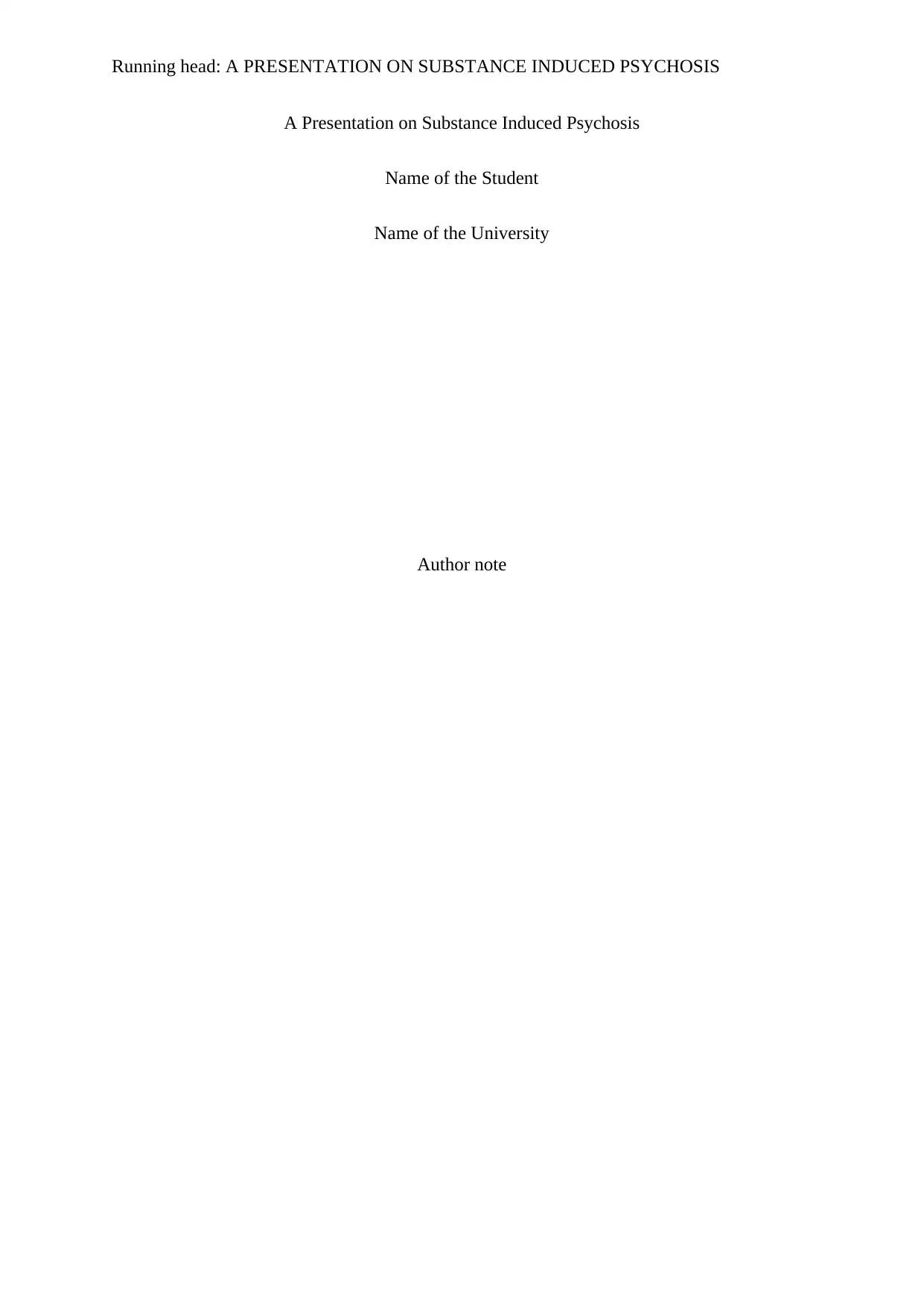
Running head: A PRESENTATION ON SUBSTANCE INDUCED PSYCHOSIS
A Presentation on Substance Induced Psychosis
Name of the Student
Name of the University
Author note
A Presentation on Substance Induced Psychosis
Name of the Student
Name of the University
Author note
Secure Best Marks with AI Grader
Need help grading? Try our AI Grader for instant feedback on your assignments.

1A PRESENTATION ON SUBSTANCE INDUCED PSYCHOSIS
Table of Contents
Introduction................................................................................................................................2
Discussion..................................................................................................................................3
1. Critical Analysis of Comprehensive Information related to Aetiology of Substance-
Induced Psychosis......................................................................................................................3
Psychosis and Substance Induced Psychosis:........................................................................3
Cannabis and Cannabinoid as cause of Psychosis.................................................................3
Use of other Intoxications and Stimulants.............................................................................4
2. Relevant Signs and symptoms leading to Diagnosis..........................................................5
Severity of Symptoms............................................................................................................6
3. Evidence-Based Pharmacological Treatment of the Substance-Induced Psychosis...........6
4. Evidence-Based Non-Pharmacological Treatment of the Substance-Induced Psychosis. .8
5. Potential Nursing Challenges..............................................................................................9
Conclusion..................................................................................................................................9
References................................................................................................................................11
Table of Contents
Introduction................................................................................................................................2
Discussion..................................................................................................................................3
1. Critical Analysis of Comprehensive Information related to Aetiology of Substance-
Induced Psychosis......................................................................................................................3
Psychosis and Substance Induced Psychosis:........................................................................3
Cannabis and Cannabinoid as cause of Psychosis.................................................................3
Use of other Intoxications and Stimulants.............................................................................4
2. Relevant Signs and symptoms leading to Diagnosis..........................................................5
Severity of Symptoms............................................................................................................6
3. Evidence-Based Pharmacological Treatment of the Substance-Induced Psychosis...........6
4. Evidence-Based Non-Pharmacological Treatment of the Substance-Induced Psychosis. .8
5. Potential Nursing Challenges..............................................................................................9
Conclusion..................................................................................................................................9
References................................................................................................................................11
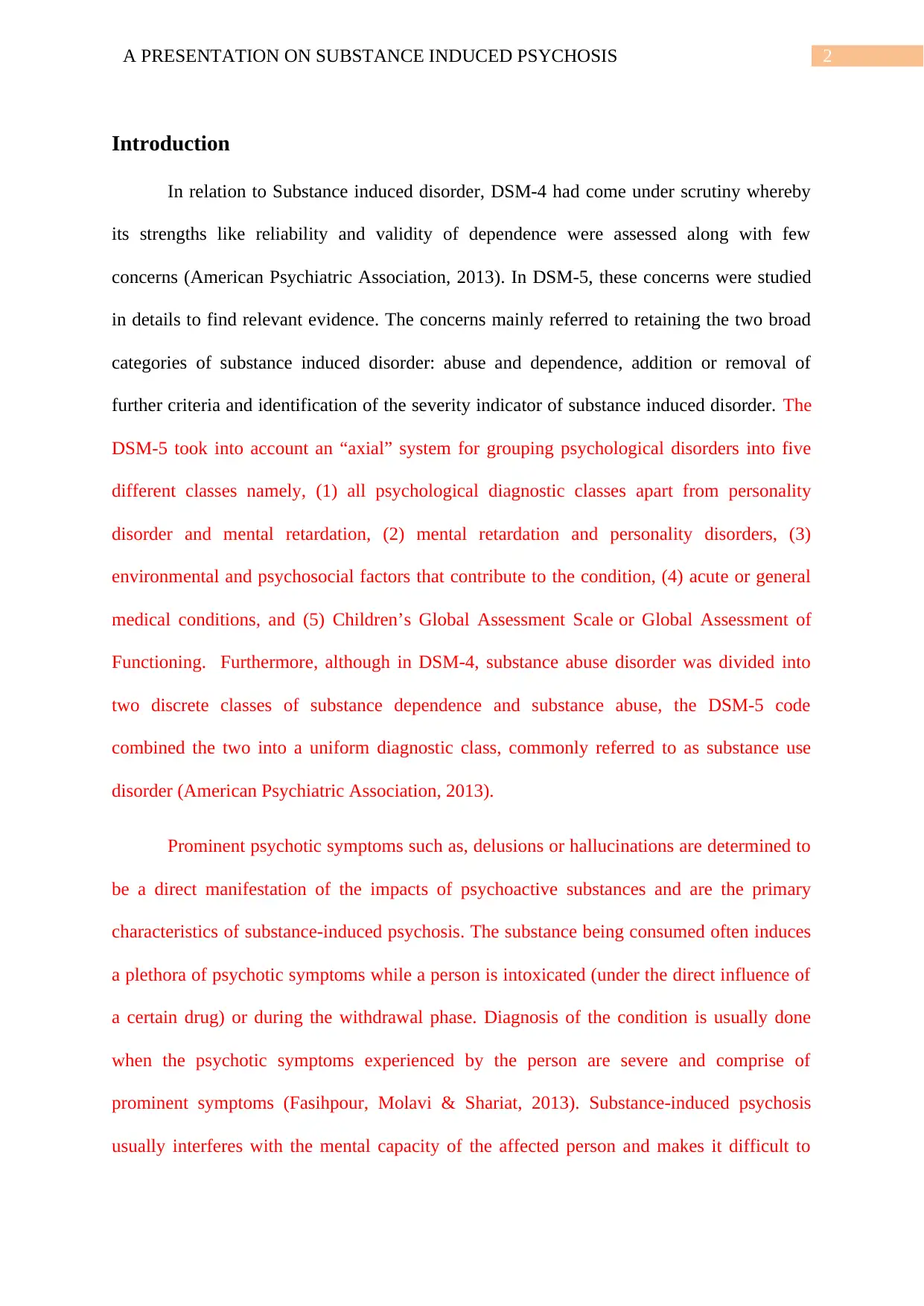
2A PRESENTATION ON SUBSTANCE INDUCED PSYCHOSIS
Introduction
In relation to Substance induced disorder, DSM-4 had come under scrutiny whereby
its strengths like reliability and validity of dependence were assessed along with few
concerns (American Psychiatric Association, 2013). In DSM-5, these concerns were studied
in details to find relevant evidence. The concerns mainly referred to retaining the two broad
categories of substance induced disorder: abuse and dependence, addition or removal of
further criteria and identification of the severity indicator of substance induced disorder. The
DSM-5 took into account an “axial” system for grouping psychological disorders into five
different classes namely, (1) all psychological diagnostic classes apart from personality
disorder and mental retardation, (2) mental retardation and personality disorders, (3)
environmental and psychosocial factors that contribute to the condition, (4) acute or general
medical conditions, and (5) Children’s Global Assessment Scale or Global Assessment of
Functioning. Furthermore, although in DSM-4, substance abuse disorder was divided into
two discrete classes of substance dependence and substance abuse, the DSM-5 code
combined the two into a uniform diagnostic class, commonly referred to as substance use
disorder (American Psychiatric Association, 2013).
Prominent psychotic symptoms such as, delusions or hallucinations are determined to
be a direct manifestation of the impacts of psychoactive substances and are the primary
characteristics of substance-induced psychosis. The substance being consumed often induces
a plethora of psychotic symptoms while a person is intoxicated (under the direct influence of
a certain drug) or during the withdrawal phase. Diagnosis of the condition is usually done
when the psychotic symptoms experienced by the person are severe and comprise of
prominent symptoms (Fasihpour, Molavi & Shariat, 2013). Substance-induced psychosis
usually interferes with the mental capacity of the affected person and makes it difficult to
Introduction
In relation to Substance induced disorder, DSM-4 had come under scrutiny whereby
its strengths like reliability and validity of dependence were assessed along with few
concerns (American Psychiatric Association, 2013). In DSM-5, these concerns were studied
in details to find relevant evidence. The concerns mainly referred to retaining the two broad
categories of substance induced disorder: abuse and dependence, addition or removal of
further criteria and identification of the severity indicator of substance induced disorder. The
DSM-5 took into account an “axial” system for grouping psychological disorders into five
different classes namely, (1) all psychological diagnostic classes apart from personality
disorder and mental retardation, (2) mental retardation and personality disorders, (3)
environmental and psychosocial factors that contribute to the condition, (4) acute or general
medical conditions, and (5) Children’s Global Assessment Scale or Global Assessment of
Functioning. Furthermore, although in DSM-4, substance abuse disorder was divided into
two discrete classes of substance dependence and substance abuse, the DSM-5 code
combined the two into a uniform diagnostic class, commonly referred to as substance use
disorder (American Psychiatric Association, 2013).
Prominent psychotic symptoms such as, delusions or hallucinations are determined to
be a direct manifestation of the impacts of psychoactive substances and are the primary
characteristics of substance-induced psychosis. The substance being consumed often induces
a plethora of psychotic symptoms while a person is intoxicated (under the direct influence of
a certain drug) or during the withdrawal phase. Diagnosis of the condition is usually done
when the psychotic symptoms experienced by the person are severe and comprise of
prominent symptoms (Fasihpour, Molavi & Shariat, 2013). Substance-induced psychosis
usually interferes with the mental capacity of the affected person and makes it difficult to
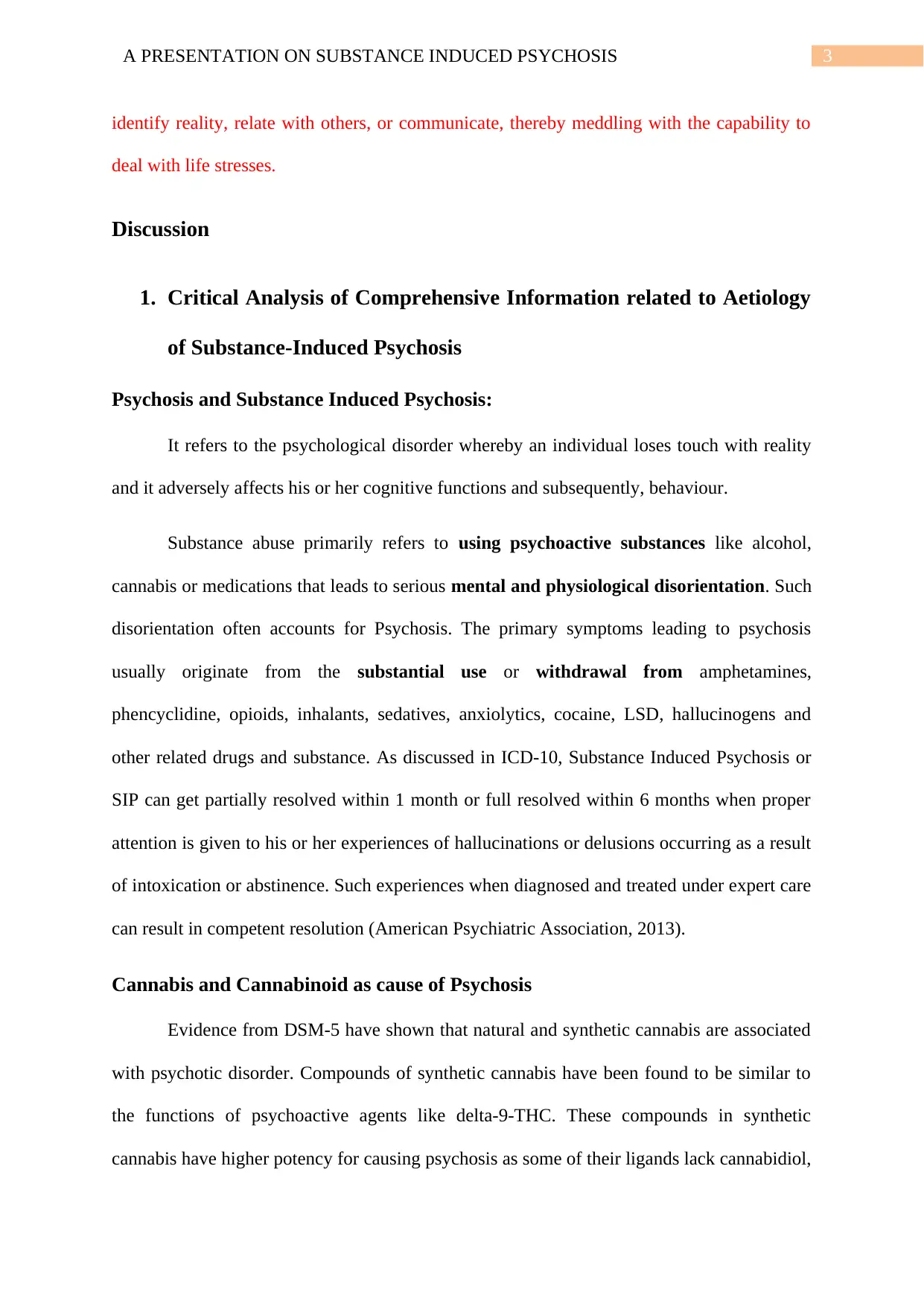
3A PRESENTATION ON SUBSTANCE INDUCED PSYCHOSIS
identify reality, relate with others, or communicate, thereby meddling with the capability to
deal with life stresses.
Discussion
1. Critical Analysis of Comprehensive Information related to Aetiology
of Substance-Induced Psychosis
Psychosis and Substance Induced Psychosis:
It refers to the psychological disorder whereby an individual loses touch with reality
and it adversely affects his or her cognitive functions and subsequently, behaviour.
Substance abuse primarily refers to using psychoactive substances like alcohol,
cannabis or medications that leads to serious mental and physiological disorientation. Such
disorientation often accounts for Psychosis. The primary symptoms leading to psychosis
usually originate from the substantial use or withdrawal from amphetamines,
phencyclidine, opioids, inhalants, sedatives, anxiolytics, cocaine, LSD, hallucinogens and
other related drugs and substance. As discussed in ICD-10, Substance Induced Psychosis or
SIP can get partially resolved within 1 month or full resolved within 6 months when proper
attention is given to his or her experiences of hallucinations or delusions occurring as a result
of intoxication or abstinence. Such experiences when diagnosed and treated under expert care
can result in competent resolution (American Psychiatric Association, 2013).
Cannabis and Cannabinoid as cause of Psychosis
Evidence from DSM-5 have shown that natural and synthetic cannabis are associated
with psychotic disorder. Compounds of synthetic cannabis have been found to be similar to
the functions of psychoactive agents like delta-9-THC. These compounds in synthetic
cannabis have higher potency for causing psychosis as some of their ligands lack cannabidiol,
identify reality, relate with others, or communicate, thereby meddling with the capability to
deal with life stresses.
Discussion
1. Critical Analysis of Comprehensive Information related to Aetiology
of Substance-Induced Psychosis
Psychosis and Substance Induced Psychosis:
It refers to the psychological disorder whereby an individual loses touch with reality
and it adversely affects his or her cognitive functions and subsequently, behaviour.
Substance abuse primarily refers to using psychoactive substances like alcohol,
cannabis or medications that leads to serious mental and physiological disorientation. Such
disorientation often accounts for Psychosis. The primary symptoms leading to psychosis
usually originate from the substantial use or withdrawal from amphetamines,
phencyclidine, opioids, inhalants, sedatives, anxiolytics, cocaine, LSD, hallucinogens and
other related drugs and substance. As discussed in ICD-10, Substance Induced Psychosis or
SIP can get partially resolved within 1 month or full resolved within 6 months when proper
attention is given to his or her experiences of hallucinations or delusions occurring as a result
of intoxication or abstinence. Such experiences when diagnosed and treated under expert care
can result in competent resolution (American Psychiatric Association, 2013).
Cannabis and Cannabinoid as cause of Psychosis
Evidence from DSM-5 have shown that natural and synthetic cannabis are associated
with psychotic disorder. Compounds of synthetic cannabis have been found to be similar to
the functions of psychoactive agents like delta-9-THC. These compounds in synthetic
cannabis have higher potency for causing psychosis as some of their ligands lack cannabidiol,
Secure Best Marks with AI Grader
Need help grading? Try our AI Grader for instant feedback on your assignments.

4A PRESENTATION ON SUBSTANCE INDUCED PSYCHOSIS
a component with antipsychotic property found in natural cannabis. Synthetic cannabis, thus,
create greater dependency in individuals which can even lead to life-threatening situations in
case of overdose.
Use of other Intoxications and Stimulants
Methamphetamine: Individuals using methamphetamine have been found to suffer more
from psychosis accounting for 52-100% in the population (Roncero et al., 2013). The
incidence is relatively higher in young users like college students. The rate of their psychotic
symptoms varies within a wide range. Evidence from further researches have also suggested
that individuals who have one or more members in their family suffering from schizophrenia
have a higher chance of developing methamphetamine induced psychosis
Cocaine: The speed of onset of Psychosis and its type usually depends on the type substance
used. Psychotic symptoms occurring from Cocaine intoxication coupled with acute changes
in abstinence causes dopaminergic changes in brain function leading to persecutory
delusions such as formication (Hasin et al., 2013).
LSD: It has been heavily linked with hallucinogenic properties originating from the
serotonin-2A receptor (5-HT2A), eventually leading to the emergence of psychotic
symptoms. Individuals are at high risk of developing a second episode of psychotic syndrome
if they resume the intake of these drugs (Hasin et al., 2016).
Alcohol: Researches have revealed comparatively lesser evidence on the correlation between
alcohol abuse and psychosis. However, in case of most patients, their early stages have been
found to be linked with alcohol use. The characteristics included auditory, visual or tactile
hallucinations which were significant even on withdrawal (Hasin et al., 2015).
a component with antipsychotic property found in natural cannabis. Synthetic cannabis, thus,
create greater dependency in individuals which can even lead to life-threatening situations in
case of overdose.
Use of other Intoxications and Stimulants
Methamphetamine: Individuals using methamphetamine have been found to suffer more
from psychosis accounting for 52-100% in the population (Roncero et al., 2013). The
incidence is relatively higher in young users like college students. The rate of their psychotic
symptoms varies within a wide range. Evidence from further researches have also suggested
that individuals who have one or more members in their family suffering from schizophrenia
have a higher chance of developing methamphetamine induced psychosis
Cocaine: The speed of onset of Psychosis and its type usually depends on the type substance
used. Psychotic symptoms occurring from Cocaine intoxication coupled with acute changes
in abstinence causes dopaminergic changes in brain function leading to persecutory
delusions such as formication (Hasin et al., 2013).
LSD: It has been heavily linked with hallucinogenic properties originating from the
serotonin-2A receptor (5-HT2A), eventually leading to the emergence of psychotic
symptoms. Individuals are at high risk of developing a second episode of psychotic syndrome
if they resume the intake of these drugs (Hasin et al., 2016).
Alcohol: Researches have revealed comparatively lesser evidence on the correlation between
alcohol abuse and psychosis. However, in case of most patients, their early stages have been
found to be linked with alcohol use. The characteristics included auditory, visual or tactile
hallucinations which were significant even on withdrawal (Hasin et al., 2015).
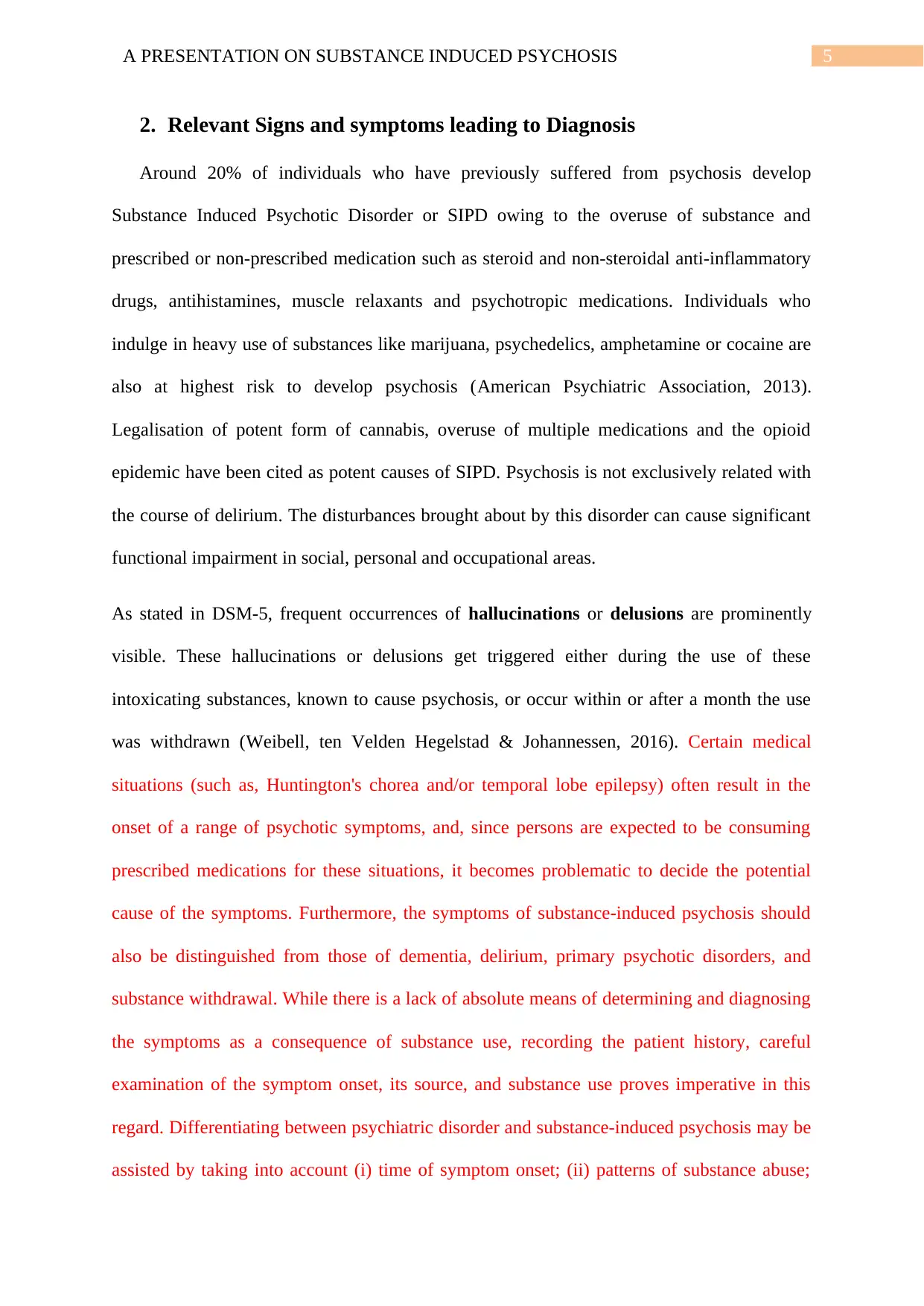
5A PRESENTATION ON SUBSTANCE INDUCED PSYCHOSIS
2. Relevant Signs and symptoms leading to Diagnosis
Around 20% of individuals who have previously suffered from psychosis develop
Substance Induced Psychotic Disorder or SIPD owing to the overuse of substance and
prescribed or non-prescribed medication such as steroid and non-steroidal anti-inflammatory
drugs, antihistamines, muscle relaxants and psychotropic medications. Individuals who
indulge in heavy use of substances like marijuana, psychedelics, amphetamine or cocaine are
also at highest risk to develop psychosis (American Psychiatric Association, 2013).
Legalisation of potent form of cannabis, overuse of multiple medications and the opioid
epidemic have been cited as potent causes of SIPD. Psychosis is not exclusively related with
the course of delirium. The disturbances brought about by this disorder can cause significant
functional impairment in social, personal and occupational areas.
As stated in DSM-5, frequent occurrences of hallucinations or delusions are prominently
visible. These hallucinations or delusions get triggered either during the use of these
intoxicating substances, known to cause psychosis, or occur within or after a month the use
was withdrawn (Weibell, ten Velden Hegelstad & Johannessen, 2016). Certain medical
situations (such as, Huntington's chorea and/or temporal lobe epilepsy) often result in the
onset of a range of psychotic symptoms, and, since persons are expected to be consuming
prescribed medications for these situations, it becomes problematic to decide the potential
cause of the symptoms. Furthermore, the symptoms of substance-induced psychosis should
also be distinguished from those of dementia, delirium, primary psychotic disorders, and
substance withdrawal. While there is a lack of absolute means of determining and diagnosing
the symptoms as a consequence of substance use, recording the patient history, careful
examination of the symptom onset, its source, and substance use proves imperative in this
regard. Differentiating between psychiatric disorder and substance-induced psychosis may be
assisted by taking into account (i) time of symptom onset; (ii) patterns of substance abuse;
2. Relevant Signs and symptoms leading to Diagnosis
Around 20% of individuals who have previously suffered from psychosis develop
Substance Induced Psychotic Disorder or SIPD owing to the overuse of substance and
prescribed or non-prescribed medication such as steroid and non-steroidal anti-inflammatory
drugs, antihistamines, muscle relaxants and psychotropic medications. Individuals who
indulge in heavy use of substances like marijuana, psychedelics, amphetamine or cocaine are
also at highest risk to develop psychosis (American Psychiatric Association, 2013).
Legalisation of potent form of cannabis, overuse of multiple medications and the opioid
epidemic have been cited as potent causes of SIPD. Psychosis is not exclusively related with
the course of delirium. The disturbances brought about by this disorder can cause significant
functional impairment in social, personal and occupational areas.
As stated in DSM-5, frequent occurrences of hallucinations or delusions are prominently
visible. These hallucinations or delusions get triggered either during the use of these
intoxicating substances, known to cause psychosis, or occur within or after a month the use
was withdrawn (Weibell, ten Velden Hegelstad & Johannessen, 2016). Certain medical
situations (such as, Huntington's chorea and/or temporal lobe epilepsy) often result in the
onset of a range of psychotic symptoms, and, since persons are expected to be consuming
prescribed medications for these situations, it becomes problematic to decide the potential
cause of the symptoms. Furthermore, the symptoms of substance-induced psychosis should
also be distinguished from those of dementia, delirium, primary psychotic disorders, and
substance withdrawal. While there is a lack of absolute means of determining and diagnosing
the symptoms as a consequence of substance use, recording the patient history, careful
examination of the symptom onset, its source, and substance use proves imperative in this
regard. Differentiating between psychiatric disorder and substance-induced psychosis may be
assisted by taking into account (i) time of symptom onset; (ii) patterns of substance abuse;
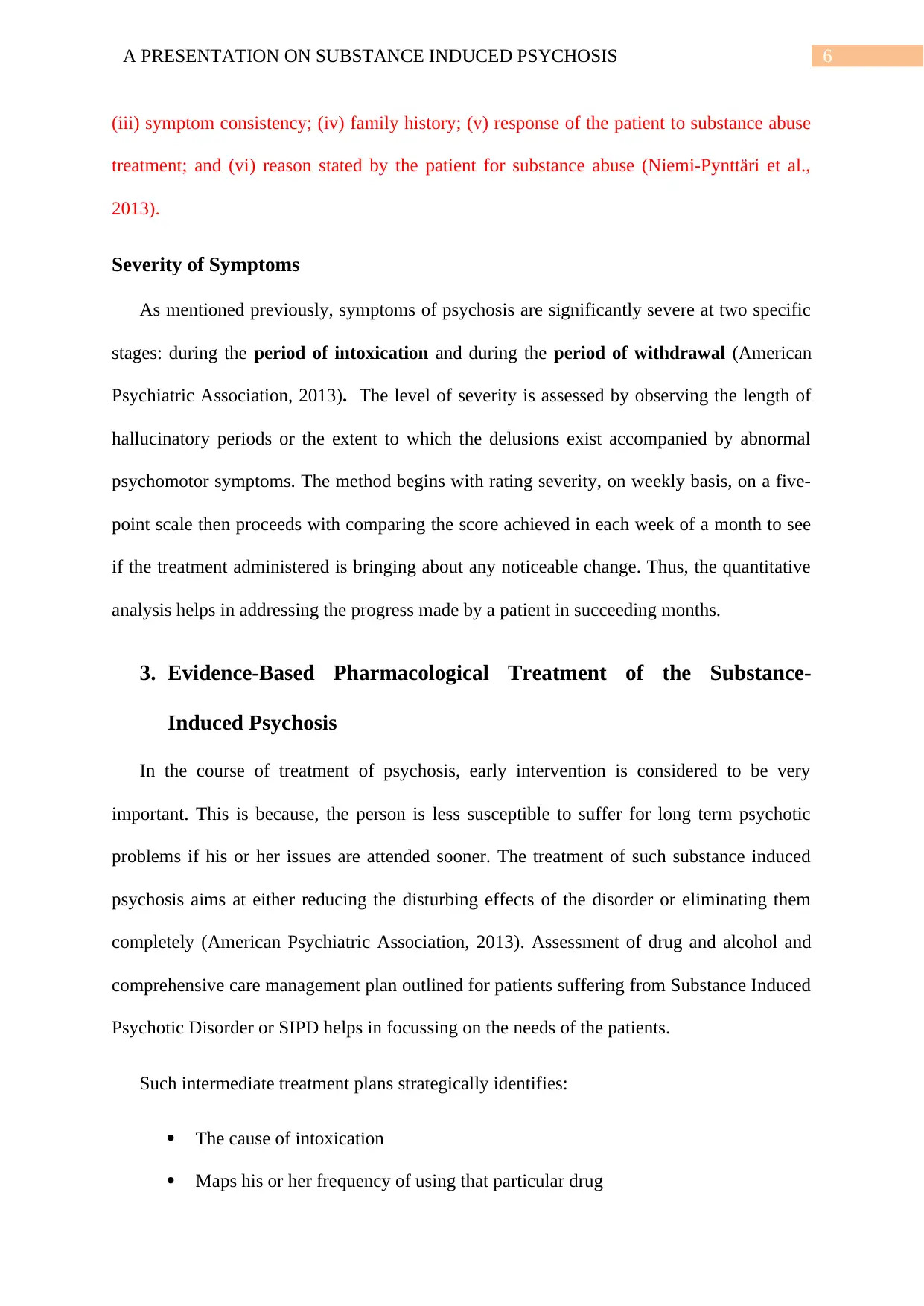
6A PRESENTATION ON SUBSTANCE INDUCED PSYCHOSIS
(iii) symptom consistency; (iv) family history; (v) response of the patient to substance abuse
treatment; and (vi) reason stated by the patient for substance abuse (Niemi-Pynttäri et al.,
2013).
Severity of Symptoms
As mentioned previously, symptoms of psychosis are significantly severe at two specific
stages: during the period of intoxication and during the period of withdrawal (American
Psychiatric Association, 2013). The level of severity is assessed by observing the length of
hallucinatory periods or the extent to which the delusions exist accompanied by abnormal
psychomotor symptoms. The method begins with rating severity, on weekly basis, on a five-
point scale then proceeds with comparing the score achieved in each week of a month to see
if the treatment administered is bringing about any noticeable change. Thus, the quantitative
analysis helps in addressing the progress made by a patient in succeeding months.
3. Evidence-Based Pharmacological Treatment of the Substance-
Induced Psychosis
In the course of treatment of psychosis, early intervention is considered to be very
important. This is because, the person is less susceptible to suffer for long term psychotic
problems if his or her issues are attended sooner. The treatment of such substance induced
psychosis aims at either reducing the disturbing effects of the disorder or eliminating them
completely (American Psychiatric Association, 2013). Assessment of drug and alcohol and
comprehensive care management plan outlined for patients suffering from Substance Induced
Psychotic Disorder or SIPD helps in focussing on the needs of the patients.
Such intermediate treatment plans strategically identifies:
The cause of intoxication
Maps his or her frequency of using that particular drug
(iii) symptom consistency; (iv) family history; (v) response of the patient to substance abuse
treatment; and (vi) reason stated by the patient for substance abuse (Niemi-Pynttäri et al.,
2013).
Severity of Symptoms
As mentioned previously, symptoms of psychosis are significantly severe at two specific
stages: during the period of intoxication and during the period of withdrawal (American
Psychiatric Association, 2013). The level of severity is assessed by observing the length of
hallucinatory periods or the extent to which the delusions exist accompanied by abnormal
psychomotor symptoms. The method begins with rating severity, on weekly basis, on a five-
point scale then proceeds with comparing the score achieved in each week of a month to see
if the treatment administered is bringing about any noticeable change. Thus, the quantitative
analysis helps in addressing the progress made by a patient in succeeding months.
3. Evidence-Based Pharmacological Treatment of the Substance-
Induced Psychosis
In the course of treatment of psychosis, early intervention is considered to be very
important. This is because, the person is less susceptible to suffer for long term psychotic
problems if his or her issues are attended sooner. The treatment of such substance induced
psychosis aims at either reducing the disturbing effects of the disorder or eliminating them
completely (American Psychiatric Association, 2013). Assessment of drug and alcohol and
comprehensive care management plan outlined for patients suffering from Substance Induced
Psychotic Disorder or SIPD helps in focussing on the needs of the patients.
Such intermediate treatment plans strategically identifies:
The cause of intoxication
Maps his or her frequency of using that particular drug
Paraphrase This Document
Need a fresh take? Get an instant paraphrase of this document with our AI Paraphraser

7A PRESENTATION ON SUBSTANCE INDUCED PSYCHOSIS
Evaluates the level of risk
Proceeds on administering the treatment.
Such treatment includes pharmacotherapeutic regimens like prescribing amphetamine for
Methamphetamine induced psychosis. However, the clinicians are advised to abstain from
depending heavily on curative drugs like Methadone unless the situation is highly critical and
demands a harm reduction plan (Karila et al., 2014). Evidences have established
amphetamine as a potent CNS stimulant that produces modest improvements in working
memory, cognition, attention, inhibitory control, and long-term episodic memory, when
prescribed at low therapeutic doses (Pérez‐Mañá et al., 2013). However, potential side effects
of the drug include hypotension, hypertension, Raynaud’s phenomenon, abdominal pain,
nausea, loss of appetite, and profuse sweating. Furthermore, it might also increase alertness,
self-confidence, apprehension, insomnia, and mood swings. Methamphetamine contains a
mixture of dextromethamphetamine and levomethamphetamine and is a strong CNS
stimulant. Nonetheless, it might lead to the onset of euphoria, alterness, alteration in libido,
dysphoria, grandiosity, and obsessive behaviours among the patients (McKetin et al., 2013).
Only those compounds of Benzodiazepines need to be preferably used that are long-
acting because it is advisable to use this drug for a short duration. This category of
psychoactive drugs most commonly act on the GABAA receptor and lead to a hypnotic,
sedative, and anxiolytic effect on the affected person. However, most prevalent side effects
are realted to their mucle relaxing and sedation actions. The drug can induce dizziness,
drowsiness, and reduced alertness (Jones, Paulozzi & Mack, 2014). Additionally, it has also
been associated with an impairment in driving skills, disinhibition and depressive disorder.
Before beginning with any prescribed pharmacological care, the clinicians need to
consider all those non-prescribed medicinal drugs that the patient had been taking to reduce
Evaluates the level of risk
Proceeds on administering the treatment.
Such treatment includes pharmacotherapeutic regimens like prescribing amphetamine for
Methamphetamine induced psychosis. However, the clinicians are advised to abstain from
depending heavily on curative drugs like Methadone unless the situation is highly critical and
demands a harm reduction plan (Karila et al., 2014). Evidences have established
amphetamine as a potent CNS stimulant that produces modest improvements in working
memory, cognition, attention, inhibitory control, and long-term episodic memory, when
prescribed at low therapeutic doses (Pérez‐Mañá et al., 2013). However, potential side effects
of the drug include hypotension, hypertension, Raynaud’s phenomenon, abdominal pain,
nausea, loss of appetite, and profuse sweating. Furthermore, it might also increase alertness,
self-confidence, apprehension, insomnia, and mood swings. Methamphetamine contains a
mixture of dextromethamphetamine and levomethamphetamine and is a strong CNS
stimulant. Nonetheless, it might lead to the onset of euphoria, alterness, alteration in libido,
dysphoria, grandiosity, and obsessive behaviours among the patients (McKetin et al., 2013).
Only those compounds of Benzodiazepines need to be preferably used that are long-
acting because it is advisable to use this drug for a short duration. This category of
psychoactive drugs most commonly act on the GABAA receptor and lead to a hypnotic,
sedative, and anxiolytic effect on the affected person. However, most prevalent side effects
are realted to their mucle relaxing and sedation actions. The drug can induce dizziness,
drowsiness, and reduced alertness (Jones, Paulozzi & Mack, 2014). Additionally, it has also
been associated with an impairment in driving skills, disinhibition and depressive disorder.
Before beginning with any prescribed pharmacological care, the clinicians need to
consider all those non-prescribed medicinal drugs that the patient had been taking to reduce
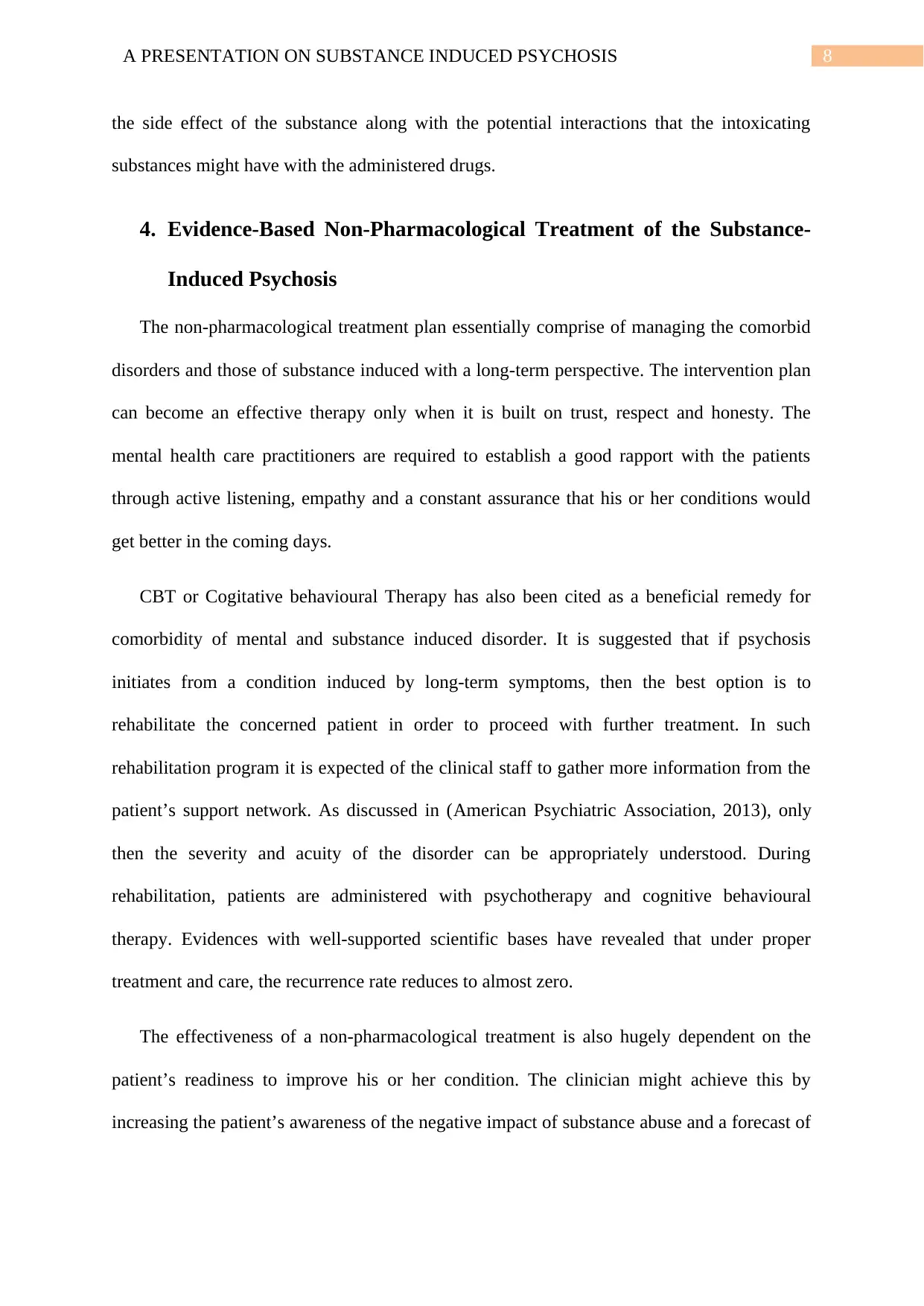
8A PRESENTATION ON SUBSTANCE INDUCED PSYCHOSIS
the side effect of the substance along with the potential interactions that the intoxicating
substances might have with the administered drugs.
4. Evidence-Based Non-Pharmacological Treatment of the Substance-
Induced Psychosis
The non-pharmacological treatment plan essentially comprise of managing the comorbid
disorders and those of substance induced with a long-term perspective. The intervention plan
can become an effective therapy only when it is built on trust, respect and honesty. The
mental health care practitioners are required to establish a good rapport with the patients
through active listening, empathy and a constant assurance that his or her conditions would
get better in the coming days.
CBT or Cogitative behavioural Therapy has also been cited as a beneficial remedy for
comorbidity of mental and substance induced disorder. It is suggested that if psychosis
initiates from a condition induced by long-term symptoms, then the best option is to
rehabilitate the concerned patient in order to proceed with further treatment. In such
rehabilitation program it is expected of the clinical staff to gather more information from the
patient’s support network. As discussed in (American Psychiatric Association, 2013), only
then the severity and acuity of the disorder can be appropriately understood. During
rehabilitation, patients are administered with psychotherapy and cognitive behavioural
therapy. Evidences with well-supported scientific bases have revealed that under proper
treatment and care, the recurrence rate reduces to almost zero.
The effectiveness of a non-pharmacological treatment is also hugely dependent on the
patient’s readiness to improve his or her condition. The clinician might achieve this by
increasing the patient’s awareness of the negative impact of substance abuse and a forecast of
the side effect of the substance along with the potential interactions that the intoxicating
substances might have with the administered drugs.
4. Evidence-Based Non-Pharmacological Treatment of the Substance-
Induced Psychosis
The non-pharmacological treatment plan essentially comprise of managing the comorbid
disorders and those of substance induced with a long-term perspective. The intervention plan
can become an effective therapy only when it is built on trust, respect and honesty. The
mental health care practitioners are required to establish a good rapport with the patients
through active listening, empathy and a constant assurance that his or her conditions would
get better in the coming days.
CBT or Cogitative behavioural Therapy has also been cited as a beneficial remedy for
comorbidity of mental and substance induced disorder. It is suggested that if psychosis
initiates from a condition induced by long-term symptoms, then the best option is to
rehabilitate the concerned patient in order to proceed with further treatment. In such
rehabilitation program it is expected of the clinical staff to gather more information from the
patient’s support network. As discussed in (American Psychiatric Association, 2013), only
then the severity and acuity of the disorder can be appropriately understood. During
rehabilitation, patients are administered with psychotherapy and cognitive behavioural
therapy. Evidences with well-supported scientific bases have revealed that under proper
treatment and care, the recurrence rate reduces to almost zero.
The effectiveness of a non-pharmacological treatment is also hugely dependent on the
patient’s readiness to improve his or her condition. The clinician might achieve this by
increasing the patient’s awareness of the negative impact of substance abuse and a forecast of
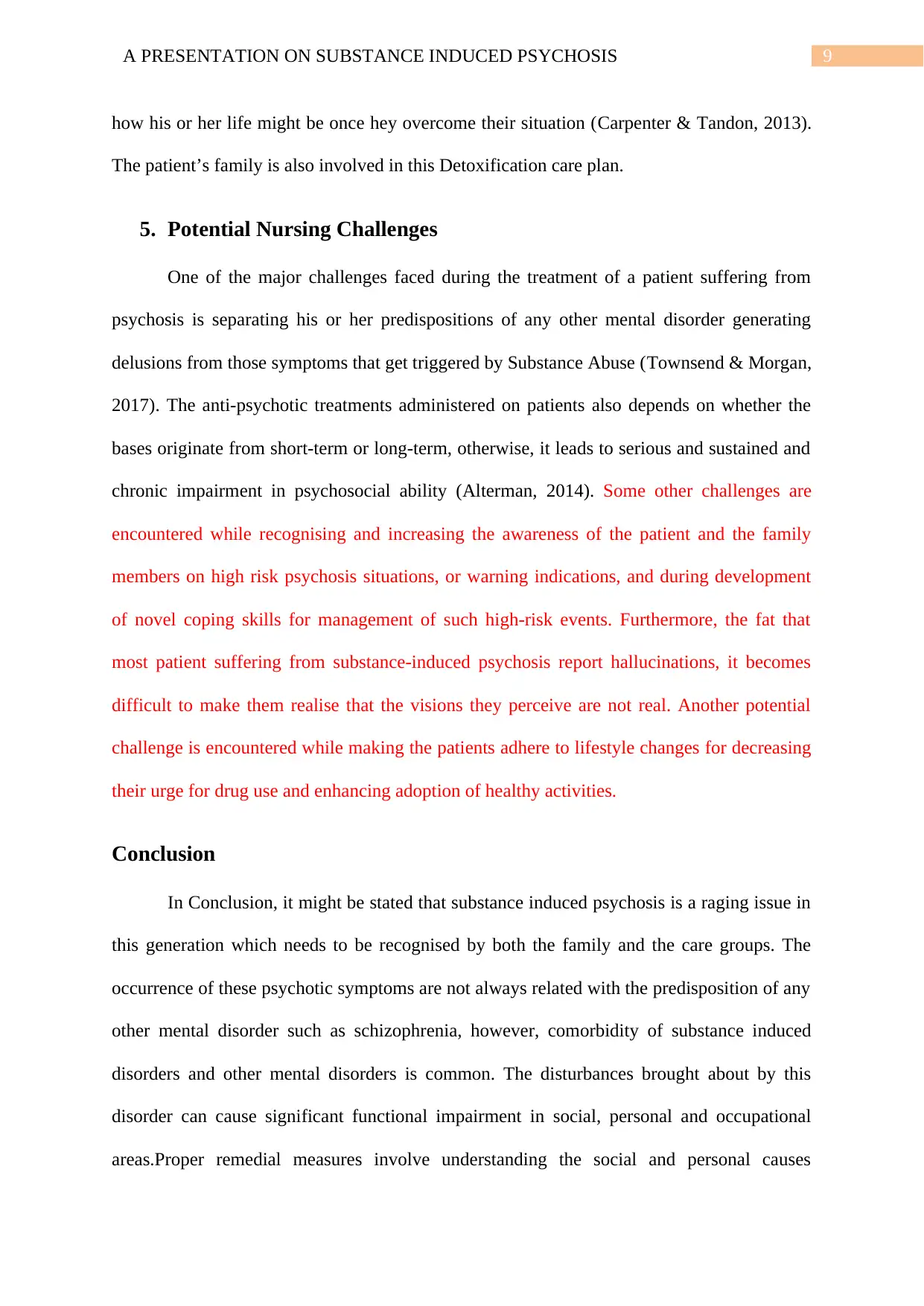
9A PRESENTATION ON SUBSTANCE INDUCED PSYCHOSIS
how his or her life might be once hey overcome their situation (Carpenter & Tandon, 2013).
The patient’s family is also involved in this Detoxification care plan.
5. Potential Nursing Challenges
One of the major challenges faced during the treatment of a patient suffering from
psychosis is separating his or her predispositions of any other mental disorder generating
delusions from those symptoms that get triggered by Substance Abuse (Townsend & Morgan,
2017). The anti-psychotic treatments administered on patients also depends on whether the
bases originate from short-term or long-term, otherwise, it leads to serious and sustained and
chronic impairment in psychosocial ability (Alterman, 2014). Some other challenges are
encountered while recognising and increasing the awareness of the patient and the family
members on high risk psychosis situations, or warning indications, and during development
of novel coping skills for management of such high-risk events. Furthermore, the fat that
most patient suffering from substance-induced psychosis report hallucinations, it becomes
difficult to make them realise that the visions they perceive are not real. Another potential
challenge is encountered while making the patients adhere to lifestyle changes for decreasing
their urge for drug use and enhancing adoption of healthy activities.
Conclusion
In Conclusion, it might be stated that substance induced psychosis is a raging issue in
this generation which needs to be recognised by both the family and the care groups. The
occurrence of these psychotic symptoms are not always related with the predisposition of any
other mental disorder such as schizophrenia, however, comorbidity of substance induced
disorders and other mental disorders is common. The disturbances brought about by this
disorder can cause significant functional impairment in social, personal and occupational
areas.Proper remedial measures involve understanding the social and personal causes
how his or her life might be once hey overcome their situation (Carpenter & Tandon, 2013).
The patient’s family is also involved in this Detoxification care plan.
5. Potential Nursing Challenges
One of the major challenges faced during the treatment of a patient suffering from
psychosis is separating his or her predispositions of any other mental disorder generating
delusions from those symptoms that get triggered by Substance Abuse (Townsend & Morgan,
2017). The anti-psychotic treatments administered on patients also depends on whether the
bases originate from short-term or long-term, otherwise, it leads to serious and sustained and
chronic impairment in psychosocial ability (Alterman, 2014). Some other challenges are
encountered while recognising and increasing the awareness of the patient and the family
members on high risk psychosis situations, or warning indications, and during development
of novel coping skills for management of such high-risk events. Furthermore, the fat that
most patient suffering from substance-induced psychosis report hallucinations, it becomes
difficult to make them realise that the visions they perceive are not real. Another potential
challenge is encountered while making the patients adhere to lifestyle changes for decreasing
their urge for drug use and enhancing adoption of healthy activities.
Conclusion
In Conclusion, it might be stated that substance induced psychosis is a raging issue in
this generation which needs to be recognised by both the family and the care groups. The
occurrence of these psychotic symptoms are not always related with the predisposition of any
other mental disorder such as schizophrenia, however, comorbidity of substance induced
disorders and other mental disorders is common. The disturbances brought about by this
disorder can cause significant functional impairment in social, personal and occupational
areas.Proper remedial measures involve understanding the social and personal causes
Secure Best Marks with AI Grader
Need help grading? Try our AI Grader for instant feedback on your assignments.
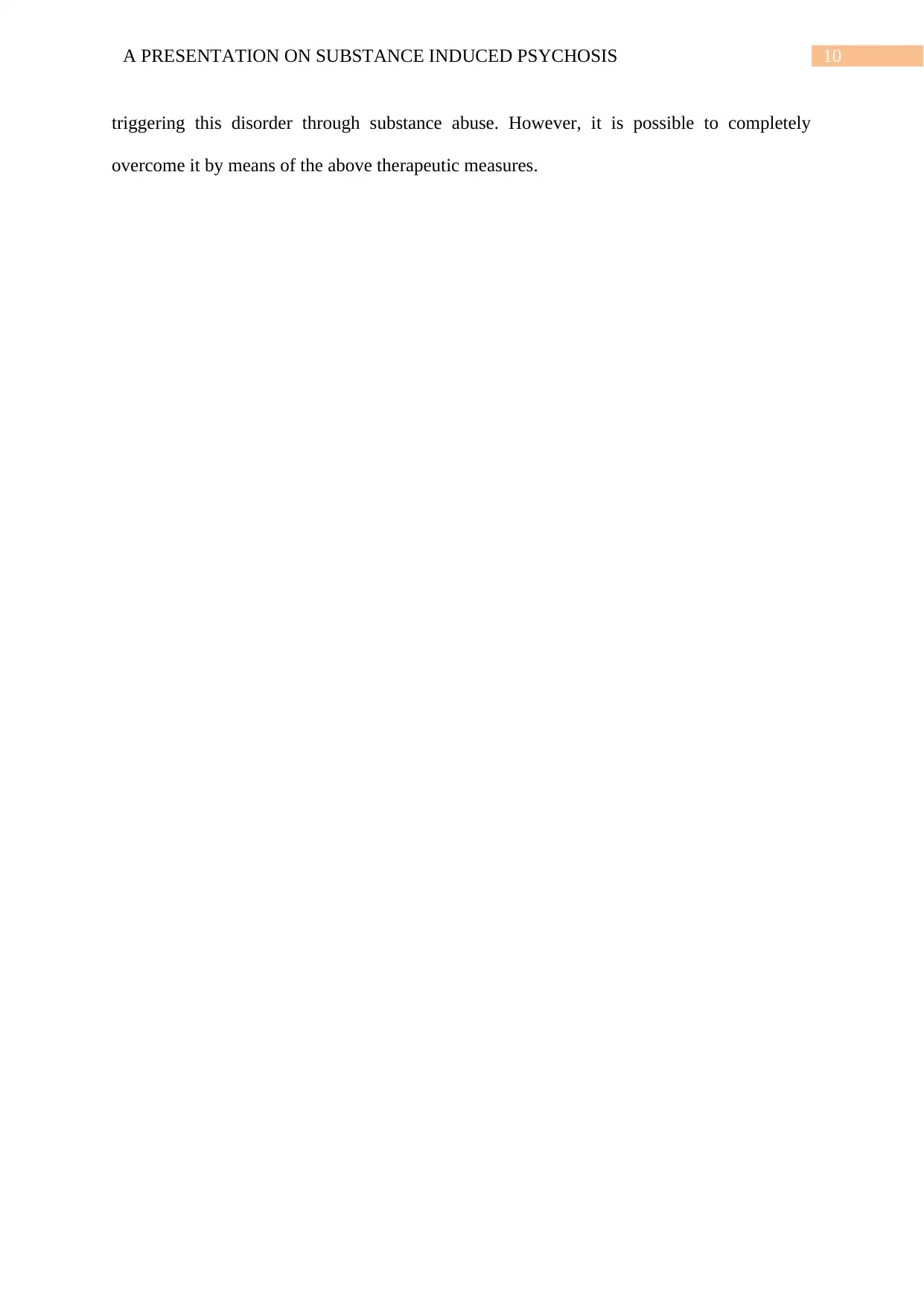
10A PRESENTATION ON SUBSTANCE INDUCED PSYCHOSIS
triggering this disorder through substance abuse. However, it is possible to completely
overcome it by means of the above therapeutic measures.
triggering this disorder through substance abuse. However, it is possible to completely
overcome it by means of the above therapeutic measures.
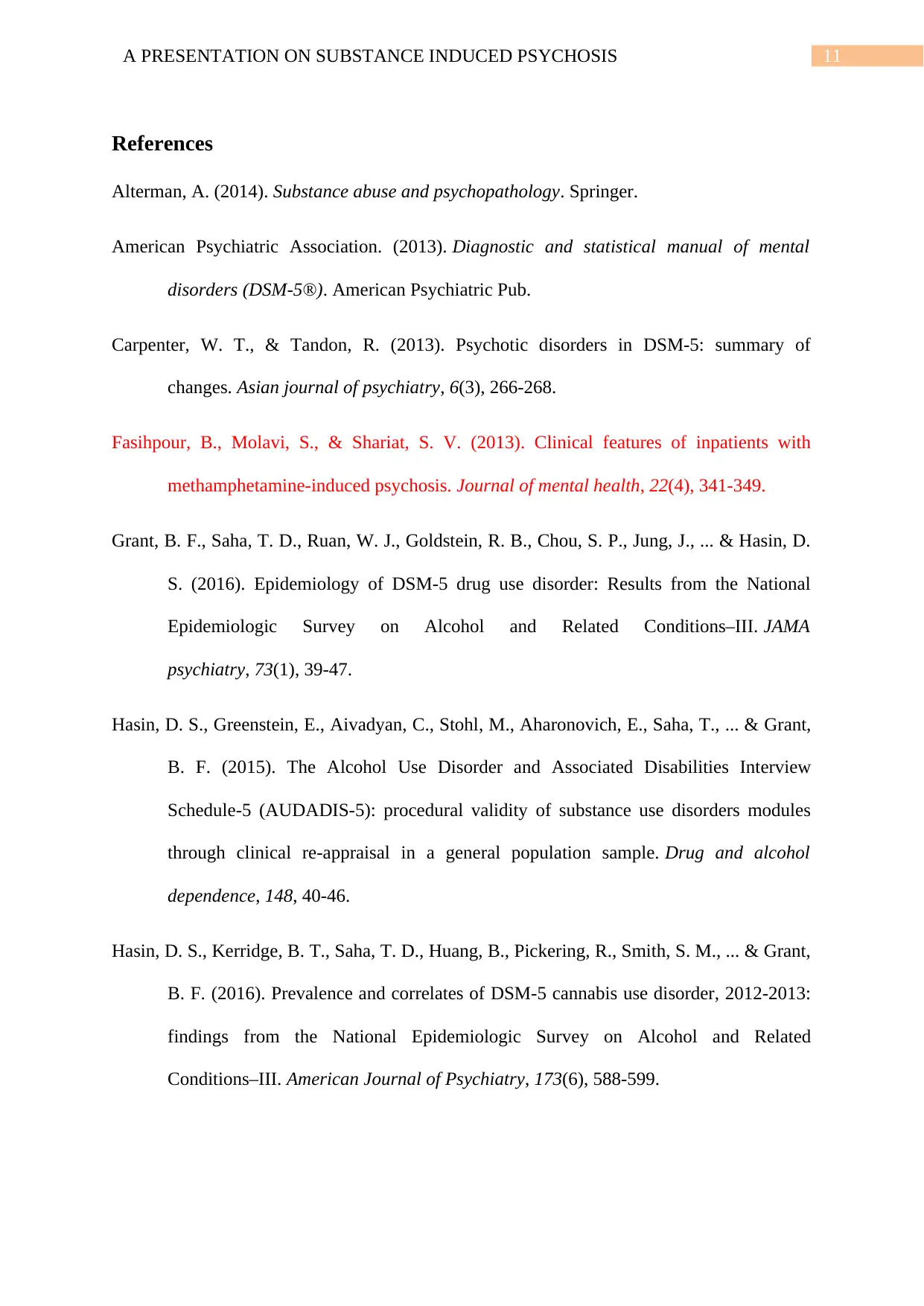
11A PRESENTATION ON SUBSTANCE INDUCED PSYCHOSIS
References
Alterman, A. (2014). Substance abuse and psychopathology. Springer.
American Psychiatric Association. (2013). Diagnostic and statistical manual of mental
disorders (DSM-5®). American Psychiatric Pub.
Carpenter, W. T., & Tandon, R. (2013). Psychotic disorders in DSM-5: summary of
changes. Asian journal of psychiatry, 6(3), 266-268.
Fasihpour, B., Molavi, S., & Shariat, S. V. (2013). Clinical features of inpatients with
methamphetamine-induced psychosis. Journal of mental health, 22(4), 341-349.
Grant, B. F., Saha, T. D., Ruan, W. J., Goldstein, R. B., Chou, S. P., Jung, J., ... & Hasin, D.
S. (2016). Epidemiology of DSM-5 drug use disorder: Results from the National
Epidemiologic Survey on Alcohol and Related Conditions–III. JAMA
psychiatry, 73(1), 39-47.
Hasin, D. S., Greenstein, E., Aivadyan, C., Stohl, M., Aharonovich, E., Saha, T., ... & Grant,
B. F. (2015). The Alcohol Use Disorder and Associated Disabilities Interview
Schedule-5 (AUDADIS-5): procedural validity of substance use disorders modules
through clinical re-appraisal in a general population sample. Drug and alcohol
dependence, 148, 40-46.
Hasin, D. S., Kerridge, B. T., Saha, T. D., Huang, B., Pickering, R., Smith, S. M., ... & Grant,
B. F. (2016). Prevalence and correlates of DSM-5 cannabis use disorder, 2012-2013:
findings from the National Epidemiologic Survey on Alcohol and Related
Conditions–III. American Journal of Psychiatry, 173(6), 588-599.
References
Alterman, A. (2014). Substance abuse and psychopathology. Springer.
American Psychiatric Association. (2013). Diagnostic and statistical manual of mental
disorders (DSM-5®). American Psychiatric Pub.
Carpenter, W. T., & Tandon, R. (2013). Psychotic disorders in DSM-5: summary of
changes. Asian journal of psychiatry, 6(3), 266-268.
Fasihpour, B., Molavi, S., & Shariat, S. V. (2013). Clinical features of inpatients with
methamphetamine-induced psychosis. Journal of mental health, 22(4), 341-349.
Grant, B. F., Saha, T. D., Ruan, W. J., Goldstein, R. B., Chou, S. P., Jung, J., ... & Hasin, D.
S. (2016). Epidemiology of DSM-5 drug use disorder: Results from the National
Epidemiologic Survey on Alcohol and Related Conditions–III. JAMA
psychiatry, 73(1), 39-47.
Hasin, D. S., Greenstein, E., Aivadyan, C., Stohl, M., Aharonovich, E., Saha, T., ... & Grant,
B. F. (2015). The Alcohol Use Disorder and Associated Disabilities Interview
Schedule-5 (AUDADIS-5): procedural validity of substance use disorders modules
through clinical re-appraisal in a general population sample. Drug and alcohol
dependence, 148, 40-46.
Hasin, D. S., Kerridge, B. T., Saha, T. D., Huang, B., Pickering, R., Smith, S. M., ... & Grant,
B. F. (2016). Prevalence and correlates of DSM-5 cannabis use disorder, 2012-2013:
findings from the National Epidemiologic Survey on Alcohol and Related
Conditions–III. American Journal of Psychiatry, 173(6), 588-599.
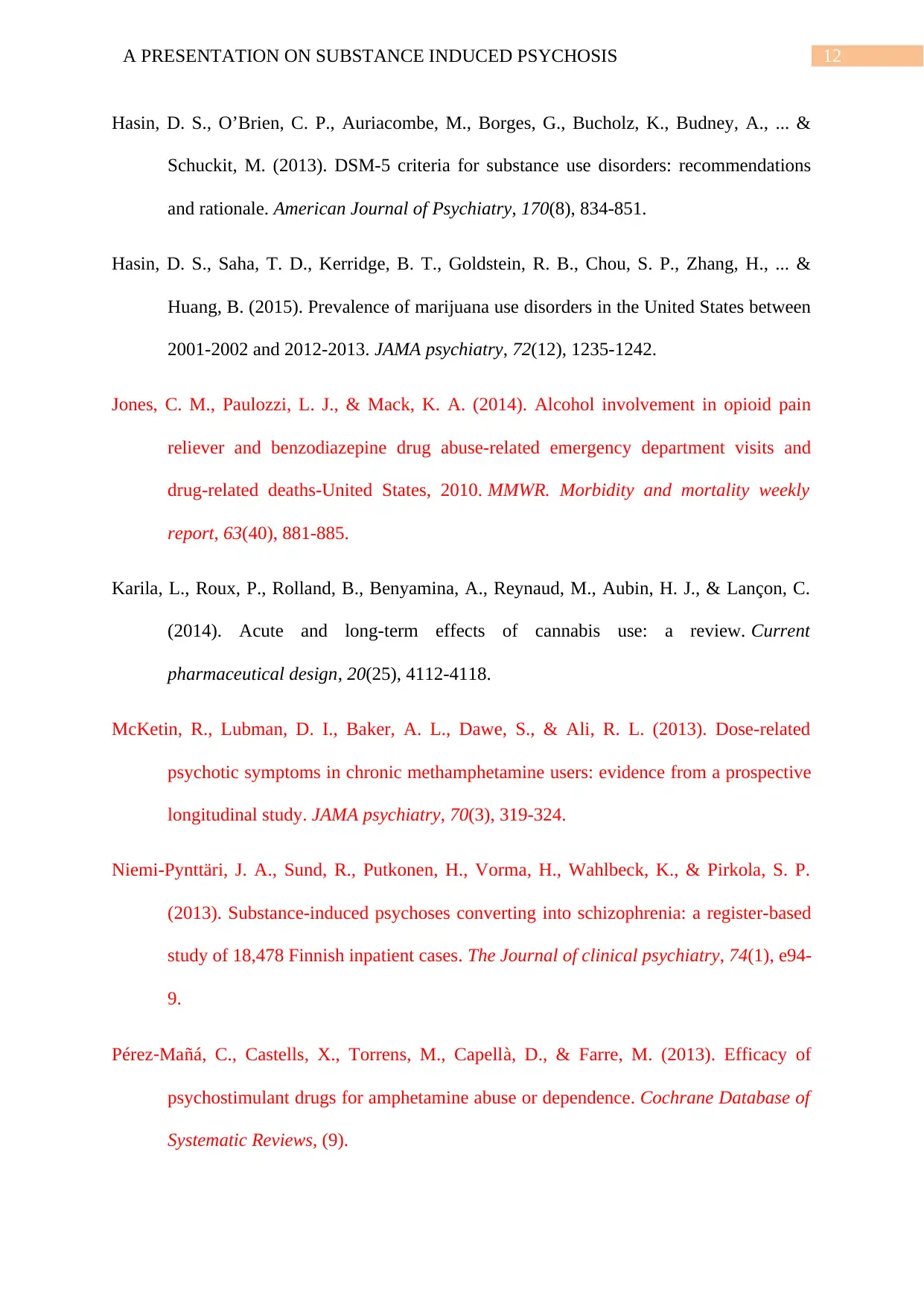
12A PRESENTATION ON SUBSTANCE INDUCED PSYCHOSIS
Hasin, D. S., O’Brien, C. P., Auriacombe, M., Borges, G., Bucholz, K., Budney, A., ... &
Schuckit, M. (2013). DSM-5 criteria for substance use disorders: recommendations
and rationale. American Journal of Psychiatry, 170(8), 834-851.
Hasin, D. S., Saha, T. D., Kerridge, B. T., Goldstein, R. B., Chou, S. P., Zhang, H., ... &
Huang, B. (2015). Prevalence of marijuana use disorders in the United States between
2001-2002 and 2012-2013. JAMA psychiatry, 72(12), 1235-1242.
Jones, C. M., Paulozzi, L. J., & Mack, K. A. (2014). Alcohol involvement in opioid pain
reliever and benzodiazepine drug abuse-related emergency department visits and
drug-related deaths-United States, 2010. MMWR. Morbidity and mortality weekly
report, 63(40), 881-885.
Karila, L., Roux, P., Rolland, B., Benyamina, A., Reynaud, M., Aubin, H. J., & Lançon, C.
(2014). Acute and long-term effects of cannabis use: a review. Current
pharmaceutical design, 20(25), 4112-4118.
McKetin, R., Lubman, D. I., Baker, A. L., Dawe, S., & Ali, R. L. (2013). Dose-related
psychotic symptoms in chronic methamphetamine users: evidence from a prospective
longitudinal study. JAMA psychiatry, 70(3), 319-324.
Niemi-Pynttäri, J. A., Sund, R., Putkonen, H., Vorma, H., Wahlbeck, K., & Pirkola, S. P.
(2013). Substance-induced psychoses converting into schizophrenia: a register-based
study of 18,478 Finnish inpatient cases. The Journal of clinical psychiatry, 74(1), e94-
9.
Pérez‐Mañá, C., Castells, X., Torrens, M., Capellà, D., & Farre, M. (2013). Efficacy of
psychostimulant drugs for amphetamine abuse or dependence. Cochrane Database of
Systematic Reviews, (9).
Hasin, D. S., O’Brien, C. P., Auriacombe, M., Borges, G., Bucholz, K., Budney, A., ... &
Schuckit, M. (2013). DSM-5 criteria for substance use disorders: recommendations
and rationale. American Journal of Psychiatry, 170(8), 834-851.
Hasin, D. S., Saha, T. D., Kerridge, B. T., Goldstein, R. B., Chou, S. P., Zhang, H., ... &
Huang, B. (2015). Prevalence of marijuana use disorders in the United States between
2001-2002 and 2012-2013. JAMA psychiatry, 72(12), 1235-1242.
Jones, C. M., Paulozzi, L. J., & Mack, K. A. (2014). Alcohol involvement in opioid pain
reliever and benzodiazepine drug abuse-related emergency department visits and
drug-related deaths-United States, 2010. MMWR. Morbidity and mortality weekly
report, 63(40), 881-885.
Karila, L., Roux, P., Rolland, B., Benyamina, A., Reynaud, M., Aubin, H. J., & Lançon, C.
(2014). Acute and long-term effects of cannabis use: a review. Current
pharmaceutical design, 20(25), 4112-4118.
McKetin, R., Lubman, D. I., Baker, A. L., Dawe, S., & Ali, R. L. (2013). Dose-related
psychotic symptoms in chronic methamphetamine users: evidence from a prospective
longitudinal study. JAMA psychiatry, 70(3), 319-324.
Niemi-Pynttäri, J. A., Sund, R., Putkonen, H., Vorma, H., Wahlbeck, K., & Pirkola, S. P.
(2013). Substance-induced psychoses converting into schizophrenia: a register-based
study of 18,478 Finnish inpatient cases. The Journal of clinical psychiatry, 74(1), e94-
9.
Pérez‐Mañá, C., Castells, X., Torrens, M., Capellà, D., & Farre, M. (2013). Efficacy of
psychostimulant drugs for amphetamine abuse or dependence. Cochrane Database of
Systematic Reviews, (9).
Paraphrase This Document
Need a fresh take? Get an instant paraphrase of this document with our AI Paraphraser
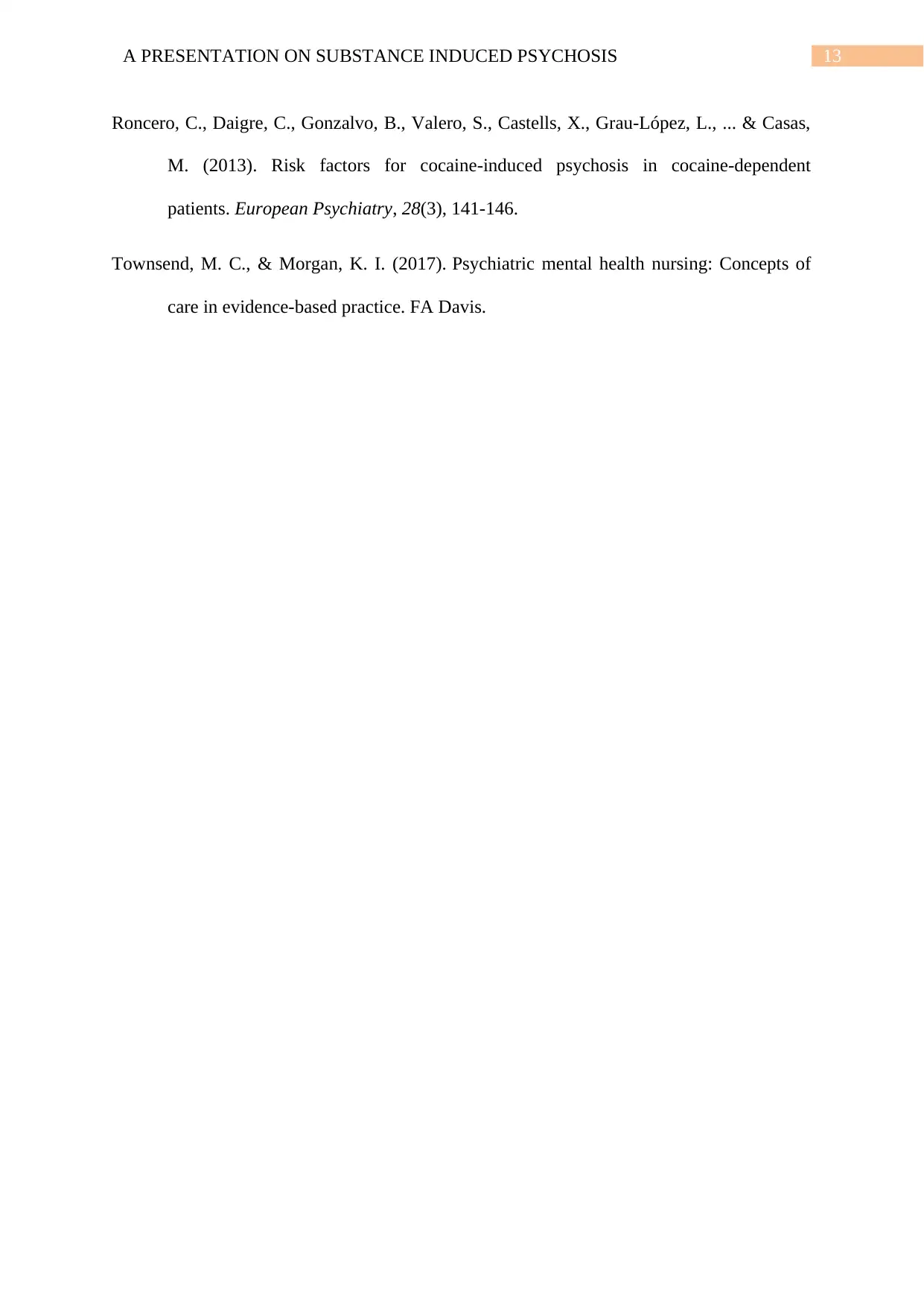
13A PRESENTATION ON SUBSTANCE INDUCED PSYCHOSIS
Roncero, C., Daigre, C., Gonzalvo, B., Valero, S., Castells, X., Grau-López, L., ... & Casas,
M. (2013). Risk factors for cocaine-induced psychosis in cocaine-dependent
patients. European Psychiatry, 28(3), 141-146.
Townsend, M. C., & Morgan, K. I. (2017). Psychiatric mental health nursing: Concepts of
care in evidence-based practice. FA Davis.
Roncero, C., Daigre, C., Gonzalvo, B., Valero, S., Castells, X., Grau-López, L., ... & Casas,
M. (2013). Risk factors for cocaine-induced psychosis in cocaine-dependent
patients. European Psychiatry, 28(3), 141-146.
Townsend, M. C., & Morgan, K. I. (2017). Psychiatric mental health nursing: Concepts of
care in evidence-based practice. FA Davis.
1 out of 14
Related Documents
Your All-in-One AI-Powered Toolkit for Academic Success.
+13062052269
info@desklib.com
Available 24*7 on WhatsApp / Email
![[object Object]](/_next/static/media/star-bottom.7253800d.svg)
Unlock your academic potential
© 2024 | Zucol Services PVT LTD | All rights reserved.





